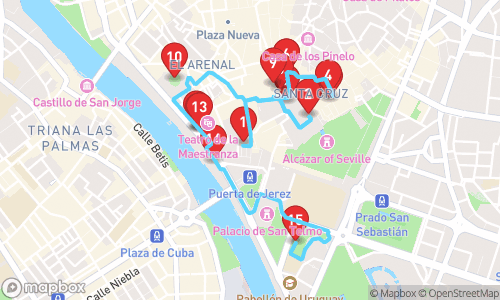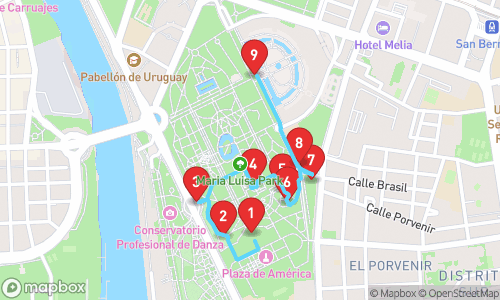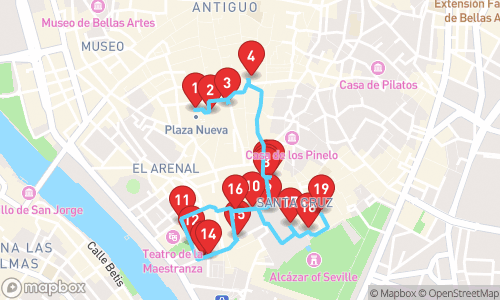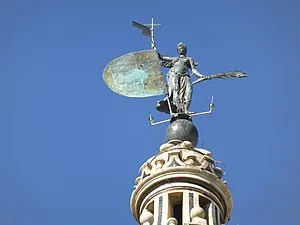

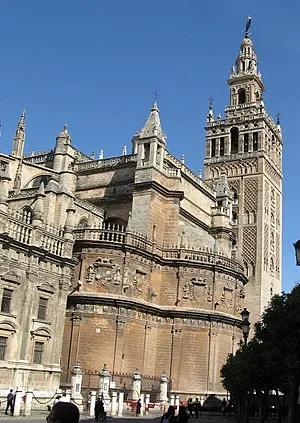
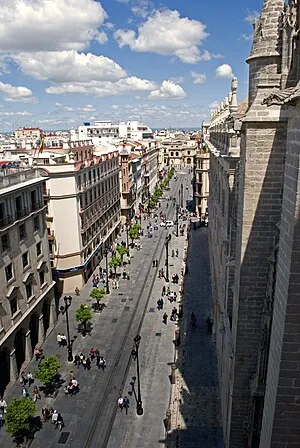
Sevilla: Een Reis Door De Geschiedenis
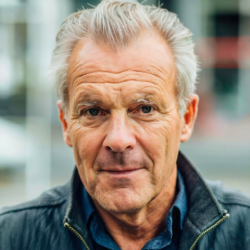
Tour Guide
Hans De Hengel
Welcome to Sevilla! On this GPS guided audio tour, we will visit 17 stops on a route of 4.84km. This tour focusses mainly on general tourism.
Locatello is an app where you can generate personal audio guided tours. Set your preferred distance, guide, language and theme, and a guided tour is created on the spot.
Walking Time
Distance
stops
Language
Tour Stops

Giraldillo
A sculpture, specifically the alegory of Fe, triumph of the church, crowning the Giralda of Seville, created in 1568 by Bartolomé Morel.

Giralda
A striking bell tower, an iconic mixture of Moorish and Renaissance architecture in Seville, Spain, built as the minaret for the Great Mosque of Seville before being converted into a cathedral bell tower in the 16th century.

Catedral de Sevilla
Catholic cathedral in Seville, Andalusia, Spain, formerly a mosque, and a UNESCO World Heritage Site since 1987.

Avenida de la Constitución
Avenida de la Constitución is a 600-meter-long avenue in the historic Casco Antiguo district of Seville, Spain, connecting Puerta de Jerez to Plaza Nueva and the Seville City Council building.
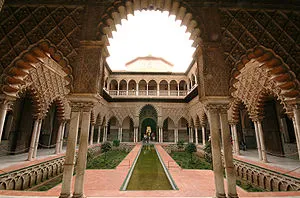
Reales Alcázares
A hydraulic structure, Reales Alcázares is a complex of palaces and gardens built by the Moorish and Gothic monarchs of Spain.

Antiguo Hospital de Venerables Sacerdotes
A former hospital turned museum, the Antiguo Hospital de Venerables Sacerdotes houses the Velázquez Center, dedicated to the life and works of Diego Velázquez. The center features exhibitions and artwork from the Golden Age of Spanish painting.
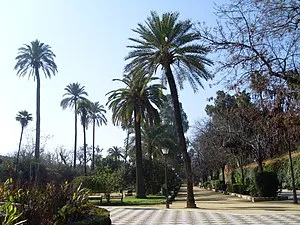
Paseo de Catalina de Ribera y Jardines de Murillo
A historic garden in Spain, Paseo de Catalina de Ribera y Jardines de Murillo is a 8,500-square-meter zone featuring five glorietas, ornate decorations, and access from the barrio Santa Cruz and the Ronda Histórica.
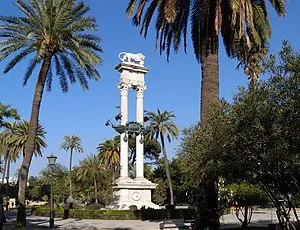
Columbus Monument
A fountain and monument to Christopher Columbus, consisting of a base, two stone columns, and a bronze statue. The monument stands 23 meters tall, featuring a lion holding an orb on top and a sculpture of Columbus' bust and the royal shield at its base.
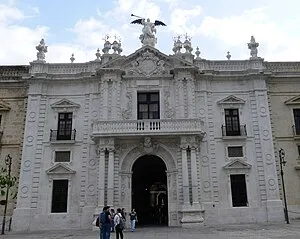
Royal Tobacco Factory of Seville
A 18th-century industrial building and former royal tobacco factory, one of the largest and most architecturally distinguished industrial buildings in Spain, with a significant example of Renaissance architecture and renovations in the 1950s for use by the University of Seville.
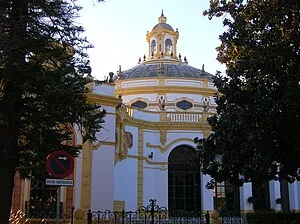
Lope de Vega Theatre
A small Baroque Revival theatre that was built for the Ibero-American Exposition of 1929 in Seville, Spain. It is named after the famous 16th-century Spanish playwright Lope de Vega.
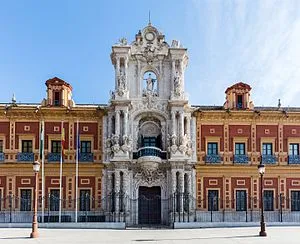
Palacio de San Telmo
A historic building in Seville, Spain, formerly the Universidad de Mareantes and later the Colegio de Marina, previously the official residence of the Duke of Montpensier, and currently the seat of the Andalusian Autonomous Government's presidency.
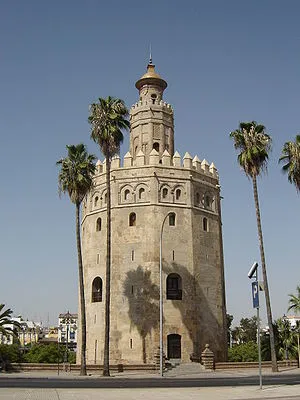
Torre del Oro
A dodecagonal military watchtower built in the 13th century to control access to Seville via the Guadalquivir river, with a name referring to its golden shine due to its building materials.

Torre de la Plata
A 13th-century octagonal military tower in Andalusia, constructed by the Almohad Caliphate, was linked by the city wall to another Moorish fortification, the Torre del Oro.
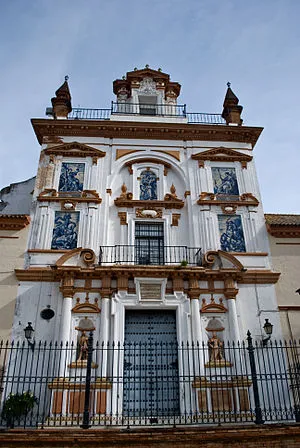
Hospital de la Santa Caridad
A Roman Catholic baroque charity hospital building, dedicated to Our Lady of Charity, founded in 1674 and still caring for the aged and infirm, featuring a chapel with sumptuous baroque sculpture and eight paintings commissioned from Bartolomé Esteban Murillo.
Audio Preview
30 sec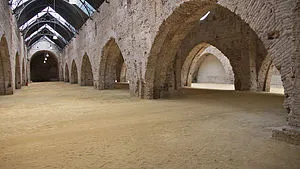
Seville Royal Shipyard
A defensive wall and historic shipyard used by the Crown of Castile since the 13th century, originally built to construct and maintain warships for naval battles, and later used for various other purposes, including storage and jail facilities.

Teatro de la Maestranza
A historic opera house, Teatro de la Maestranza is a premier cultural venue in Spain, mainly hosting opera performances, as well as Zarzuela and other musical acts. The theatre is home to the Royal Seville Symphony Orchestra and the Choir of the Friends' Society of the Maestranza Theatre.

Plaza de toros de la Maestranza
A 12,000-capacity bullring built between 1749 and 1881, featuring a circular ring, ochavas, and a scenic Palco del Príncipe with a sculptural group above the entrance.
Download App
Experience this tour and many more with our mobile app. Available for iOS and Android.
Audio Preview
Tour Map
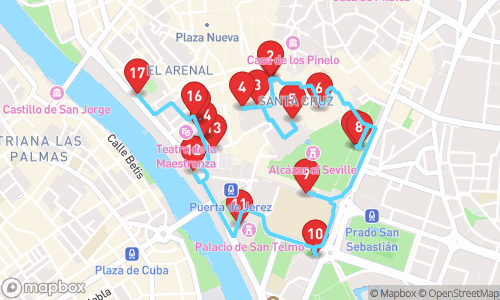
Quick Facts
- ✓GPS-guided navigation
- ✓Professional audio narration
- ✓Offline maps available
- ✓Premium content included
Why Choose This Tour
Expert Local Guide
Narrated by Jenny Multilingual, specializing in general tourism
Flexible Timing
Take the tour at your own pace, any time of day
